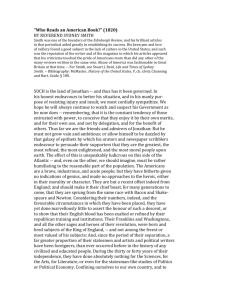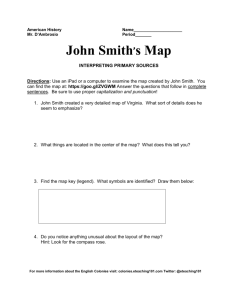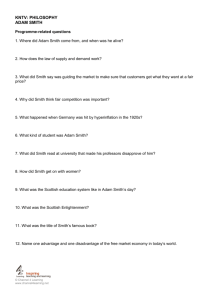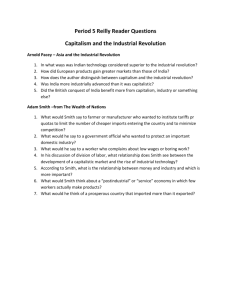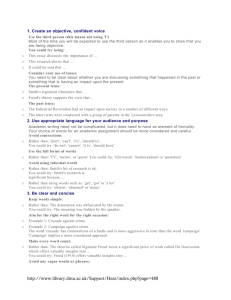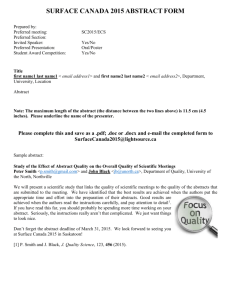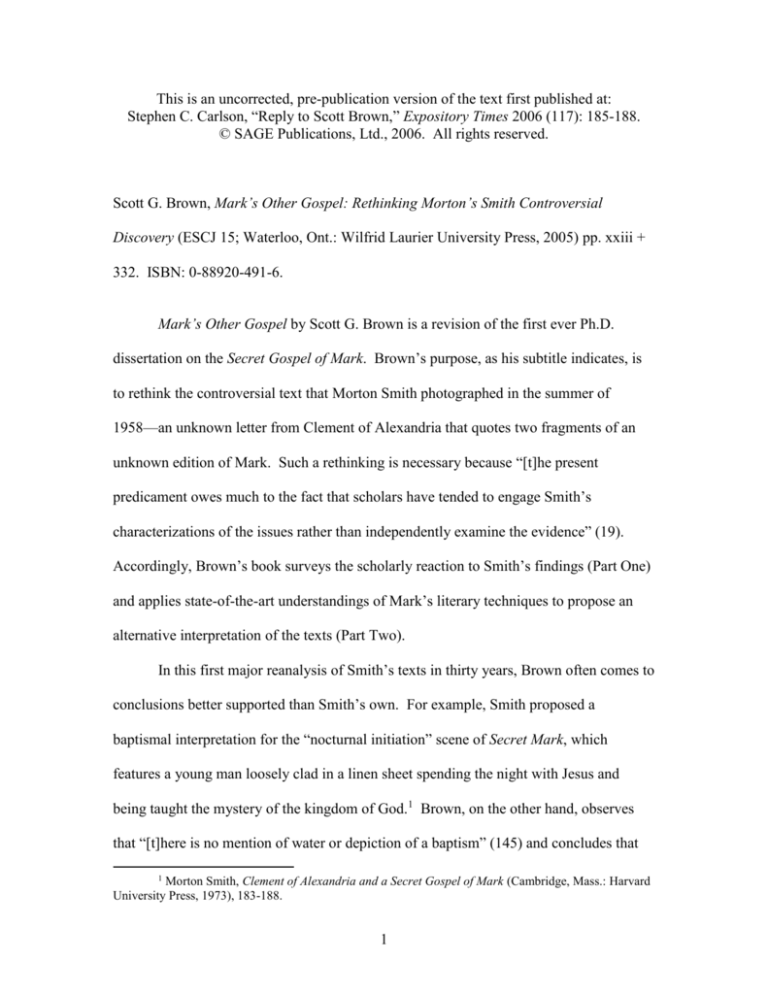
This is an uncorrected, pre-publication version of the text first published at:
Stephen C. Carlson, “Reply to Scott Brown,” Expository Times 2006 (117): 185-188.
© SAGE Publications, Ltd., 2006. All rights reserved.
Scott G. Brown, Mark’s Other Gospel: Rethinking Morton’s Smith Controversial
Discovery (ESCJ 15; Waterloo, Ont.: Wilfrid Laurier University Press, 2005) pp. xxiii +
332. ISBN: 0-88920-491-6.
Mark’s Other Gospel by Scott G. Brown is a revision of the first ever Ph.D.
dissertation on the Secret Gospel of Mark. Brown’s purpose, as his subtitle indicates, is
to rethink the controversial text that Morton Smith photographed in the summer of
1958—an unknown letter from Clement of Alexandria that quotes two fragments of an
unknown edition of Mark. Such a rethinking is necessary because “[t]he present
predicament owes much to the fact that scholars have tended to engage Smith’s
characterizations of the issues rather than independently examine the evidence” (19).
Accordingly, Brown’s book surveys the scholarly reaction to Smith’s findings (Part One)
and applies state-of-the-art understandings of Mark’s literary techniques to propose an
alternative interpretation of the texts (Part Two).
In this first major reanalysis of Smith’s texts in thirty years, Brown often comes to
conclusions better supported than Smith’s own. For example, Smith proposed a
baptismal interpretation for the “nocturnal initiation” scene of Secret Mark, which
features a young man loosely clad in a linen sheet spending the night with Jesus and
being taught the mystery of the kingdom of God.1 Brown, on the other hand, observes
that “[t]here is no mention of water or depiction of a baptism” (145) and concludes that
1
Morton Smith, Clement of Alexandria and a Secret Gospel of Mark (Cambridge, Mass.: Harvard
University Press, 1973), 183-188.
1
“the young man’s linen sheet has baptismal connotations, but the text discourages every
attempt to perceive Jesus literally baptizing him” (146). Brown’s reading of the text is
more plausible than what Smith had published.
Any rethinking of Secret Mark must address its authenticity, and Brown devotes
himself to rebutting the charge that Morton Smith had forged the text. For example,
Brown assumes that a forger “probably would have created something of greater
significance” (73), but he documents that Secret Mark had no discernable influence on
Smith’s subsequent scholarship (49-54) and that Smith “all but gave up using longer
Mark to support his theories about Jesus” (73-74). Though Smith’s behavior arguably
does not seem consistent with a malicious forgery, it also does not make sense for a
genuine discovery. Why did Smith give up on Secret Mark so easily? If anything,
scholars tend to become overly enamored with their discoveries even in the face of
contrary evidence.2 Smith’s disregarding of Secret Mark in his scholarship after 1973 is
as much a mystery for a genuine finding as it is for a typical forgery.
Brown’s answer to this mystery is to criticize Smith’s abilities. According to
Brown, Smith gave up because his interpretation was “so easily controverted by his
peers” (74). Smith also was not up to the task, Brown argues: “Smith misunderstood
what the letter conveys about the nature and use of the longer gospel and had a very
limited appreciation of the gospel extracts. He was a brilliant and erudite scholar, but he
did not comprehend the Letter to Theodore well enough to have composed it” (74). Like
many things with Secret Mark, one mystery begets another: how could a scholar reputed
to be so “brilliant and erudite” be so wrong about the text? Brown contended that
2
For example, Constantin Tischendorf; see Kurt Aland & Barbara Aland, The Text of the New
Testament: An Introduction to the Critical Editions and to the Theory and Practice of Modern Textual
Criticism (2d ed.; trans. Erroll F. Rhodes; Grand Rapids, Mich.: Eerdmans, 1989), 14.
2
Smith’s Greek was not up to the task: “Those most proficient in classical Greek tended to
think that the letter surpassed his ability” (13). Yet Smith’s bibliography belies this
claim—as early as 1945, Smith’s “Notes on Goodspeed’s ‘Problems of New Testament
Translation’” has demonstrated a deep understanding of subtle nuances in the Greek.3
Responding to Quentin Quesnell’s argument that Smith was capable of forging Secret
Mark, Brown also argued that it “is quite a presumption considering that Smith published
nothing on Clement prior to the 1970s” (38). But the presumption belongs to Brown
because Smith published an article in March of 1958 that used Clement of Alexandria’s
notion of secrecy to illustrate a point.4 Smith does not deserve Brown’s criticism of his
competence in Greek or Clement.
The second half of Brown’s book uses a literary feature called an “intercalation”
in a new argument for the authenticity of Secret Mark. 5 Intercalation, as Brown defines
it, is “the narrative device of placing one episode (story or scene) within another, separate
episode such that the completion of the first episode is delayed by the complete narration
of the second episode” (166).
A classic example is Mark 5:21-43, the intertwined
account of Jairus’s daughter and the woman with an issue of blood. This passage begins
with the request of Jairus, a synagogue ruler, for Jesus to heal his daughter (vv. 21-24).
As Jesus was going through the thronging crowds, a woman who had been bleeding for
twelve years came up to him, touched his garment, and was healed (vv. 25-34). The
3
JBL 64 (1945): 501-14.
Morton Smith, “The Image of God: Notes on the Hellenization of Judaism, with Especial
Reference to Goodenough’s Work on Jewish Symbols,” Bulletin of the John Rylands Library 40 (1958):
473-512 at 507. The periodical may be obscure, but the article had been reprinted in Shaye J. D. Cohen,
Studies in the Cult of Yahweh (RGRW 130; 2 vols.; Leiden: Brill, 1996) at 1:145.
5
Perhaps not wholly novel. Brown’s argument resembles in many respects the still controversial
argument of John W. Welch that Joseph Smith would not be familiar with chiasmus, a literary device found
in both the Old Testament and the Book of Mormon (Boyd F. Edwards and W. Farrell Edwards, “Does
Chiasmus Appear in the Book of Mormon by Chance?” BYU Studies 43 (2004): 103-130).
4
3
initial story with Jairus’s daughter then resumes with Jesus reaching Jairus’s house and
raising his daughter (vv. 35-43). This passage can be thought of as an A1-B-A2 sandwich,
in which the distinct B-episode of the healing of the hemorrhaging woman (vv. 25-24) is
embedded within—and delays the completion of—the account of the raising of Jairus’s
daughter (A1 = vv. 21-24; A2 = vv.35-43).
According to Brown, the Secret Mark fragments too form an intercalation: “In
this case, the A1-story is LGM 1 [the first Secret Mark fragment], the B-story is the
request of James and John, which culminates in a discipleship teaching (10:35-40, 4145), and the A2-story is Mark 10:46 plus LGM 2” (166). Scholarly understanding of
Mark’s literary techniques starting from von Dobschütz in 1928 has become increasingly
refined over the twentieth-century, so Brown contends that “if we agree that LGM 1 and
2 form a typically Markan intercalation, then we can rule out a modern origin for the
Letter to Theodore” (179).
This argument immediately runs into difficulty because his Secret Mark
intercalation lacks the appropriate narrative structure. The brief A2 block, which recites
that Jesus did not receive three women in Jericho, does not complete the narration of the
A1 block. Though A1 block contains two stories—the young man in the tomb in Bethany,
and the nocturnal initiation of the young man at his home—the A2 block completes
neither of the these. In fact, Brown recognizes this is a problem:
There is one notable area of difference between the definition
characteristics discussed so far and the effect achieved by inserting LGM 1 and 2
into Mark’s narrative. Whereas in the classic examples of intercalation “the
flanking A-episodes require one another to complete their narrative,” this is not
4
really the case with the LGM additions. There is no clear reason why LGM 1
should not be considered complete in itself, for LGM 2 is unnecessary as a
conclusion for LGM 1. This is very different from the raising of Jairus’s daughter
in Mark 5:35-43, for instance, which remained to be carried out after the healing
of the woman with the hemorrhage. (169)
Unaccounted for in Brown’s analysis is that the A1 story of his Secret Mark
intercalation is a composite of two different stories. The first half involves the nonresurrection account of the young man in the tomb, while the second half takes place
“after six days,” in which the young man spent the night with Jesus. Although Brown
concedes that the “A1-story, moreover, is longer than usual because it is a complete
(miracle) story, not merely an introduction” (173), Brown does not explain or even point
out the additional anomaly that his A1 story is in reality two stories spliced together.
Thus, when compared with his own definition, the Secret Mark fragments can
hardly be said to form an intercalation at all, much less a “typically Markan intercalation”
that his argument needed for authenticity. To be sure, Brown proposes a way out of his
predicament by relaxing his definition of an intercalation: “LGM 1 and 2 plus Mark
10:35-45 is not, therefore, a perfect example of intercalation, but neither are any of the
classic examples. The existing definitions of intercalation describe ideal features and
effects that are not evident in all six instances” (173).
In other words, Brown has
defined “a typically Markan intercalation” out of existence, emptying Brown’s case for
authenticity of its validity.
All is not lost, however. Brown’s insight that the evolution of the scholarly
understanding of Mark’s literary techniques throughout the twentieth century may still be
5
useful in dating Secret Mark—just not in the way he thought. The peculiarities of the
Secret Mark fragments better resemble the understandings of Mark’s composition in the
1950s than today’s improved understanding. In particular, the construction of Mark’s
account of Jairus’s daughter with the hemorrhaging woman (5:21-24, 25-34, 35-43) has
intrigued exegetes throughout the twentieth century. Rudolf Bultmann once suggested
that two separate stories had been interwoven but assigned Mark 5:21b to the B-story,
spoiling the intercalation’s A1-B-A2 pattern.6 In 1952, Vincent Taylor summarized the
contemporary understanding of the insertion of Mark 5:25-34 as follows:
In view of the comparative absence of connecting-links of this kind in
Mk., it is reasonable to infer that the connexion is historical, and not merely
literary. cf. Schmidt, 148; Dibelius, 219. Bultmann, 228 f., conjectures that
originally the two stories may have existed separately, but Schmidt holds that the
interweaving is due to historical recollection. The case is somewhat different
from iii. 22-6 and xiv. 3-9, which separate different sections or stories, and is
hardly, therefore, an example of ‘Mk’s fondness for dove-tailing one story into
another’ (Rawlinson, 42 f., 67). A story may be told to fill an interval (e.g. vi. 1429), but the intercalation of narratives is not a feature of Mark’s method.7
Even though mid-twentieth scholars had recognized that the combination of two
different stories was present in various places in Mark, they did not conceive this feature
strictly in terms of an A1-B-A2 intercalation. Rather, they viewed it more broadly as
interleaving, dovetailing, or “splicing”—even by Morton Smith himself in 1955: “But,
granting that the final redactor of Mk. did not usually form connections, it does not
6
Rudolf Bultmann, History of the Synoptic Tradition (trans. John Marsh; New York: Harper &
Row, 1963), 214.
7
Vincent Taylor, The Gospel According to St. Mark (London: Macmillan, 1952), 289.
6
follow that he never did, still less that no splicing took place before the material reached
his hands.”8
The combination of narratives evident in Secret Mark does not reflect the progress
in understanding Mark’s literary techniques since the mid-twentieth century. Today’s
scholars would expect the second fragment of Secret Mark to continue either of the
narratives begun in the first Secret Mark fragment, but it does not. Fifty years ago,
however, Markan scholars including Smith had no such expectation, which explains why
the Secret Mark fragments so poorly meet its modern definition. Furthermore, a midtwentieth century composition of Secret Mark better explains the composite nature of the
A1 portion. No sophisticated imitator today would compose an intercalation with such a
lengthy and composite A1 story, but Smith’s contemporaries merely viewed Mark’s
technique as splicing different stories, which is exactly what the first fragment of Secret
Mark does. Secret Mark is thus very much a product of its time.
Brown should be commended for the first independent analysis of Smith’s
findings since 1973. Nevertheless, it is flawed by an unrealistic appraisal of Smith’s
talents which prevented Secret Mark’s genre from being recognized. More effort should
have been spent investigating Secret Mark as a scholarly hoax, not as a malicious forgery
or as an expansion of Mark by its author.9 Understanding Secret Mark as a hoax explains
why Smith “all but gave up using longer Mark to support his theories about Jesus” (74).
This understanding also explains why Smith’s interpretations were so uncharacteristically
outlandish. They are not symptoms of Smith supposed incompetence but techniques to
Morton Smith, “Comments on Taylor’s Commentary on Mark,” HTR 48 (1995): 21-64, at 32
(emphasis added).
9
See, e.g., Stephen C. Carlson, The Gospel Hoax: Morton’s Smith Invention of Secret Mark
(Waco, Tex.: Baylor University Press, 2005).
8
7
divert scholars from a thorough reassessment of the textual evidence. Indeed, Smith’s
misdirection had been successful for over twenty years until Brown began his own study
with fresh eyes. Ultimately, Mark’s Other Gospel is a lost opportunity. With a deeper
appreciation for Morton Smith’s scholarship in the 1950s, Brown could have used his
chance as the first to write a dissertation on Secret Mark to become the first to expose its
truth.
8




